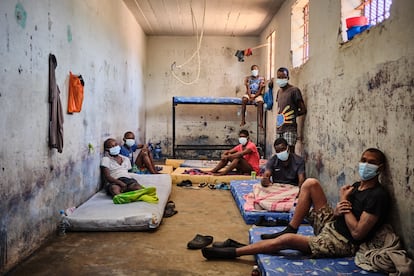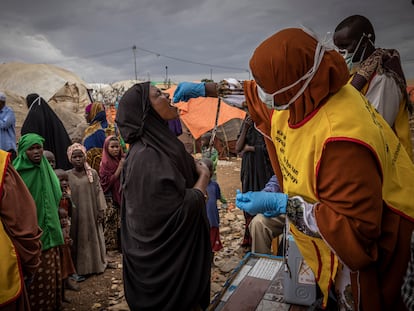Mozambique prison: “With so many people, it’s hard to know who has tuberculosis.”
The African country combats disease using AI and a community approach in overcrowded jails and mines with surging infection rates

In 2013, Kenneth Fortune, a South African, received a 17-year prison sentence for drug trafficking in Mozambique. The living conditions in the overcrowded and poorly ventilated jail with 800 beds for 3,200 inmates, create an ideal environment for the spread of tuberculosis. This bacterial disease, similar to COVID-19, spreads through the air and caused 1.3 million deaths worldwide last year. Fortune contracted the disease just two months ago. “With so many people, it’s hard to know who has tuberculosis,” he said. “I got it from people in my cell.”
Fortune lost his appetite, had high fevers with night sweats, and started coughing up blood. “I was doing really badly, so they moved me to the Maputo Central Hospital. I ended up staying there for a whole month. I just got back three weeks ago and now I’m in the process of recovering,” he told us. Sick inmates must be isolated for the first two months of treatment until they are no longer infectious, according to staff from Mozambique’s National Penitentiary Service (SERNAP).
Fortune is currently confined in a small room with peeling walls and mattresses on the floor. He shares the space with four other men who also have tuberculosis. Here, he receives medication under the direct supervision of a nurse who ensures completion of the six-month treatment.
Francesco Moyano never thought that an illness in prison would change his life. Two years ago, he was diagnosed and treated for tuberculosis in Maputo Prison. “It really hurt to find out that he was sick,” said his wife, Inés Peniva. Since his release in December 2022, Moyano has struggled to relaunch his business due to a lack of money. His wife has been the primary source of support for the family. “I had to take on the responsibility of being both a father and a mother at the same time,” said Peniva.
Mozambique’s prisons are facing a severe overcrowding issue – SERNAP operates at 45.3% over its official capacity. A study published in The Lancet reveals that the likelihood of developing tuberculosis in prisons is six to 30 times greater than in the general population. Benedita José, director of Mozambique’s National Tuberculosis Program, acknowledges that prisons present the biggest challenge in combating tuberculosis. “The incidence rate of tuberculosis among the prison population is 1,000 per 100,000 people, compared to 361 per 100,000 in the general population.”
According to the World Health Organization (WHO), the incidence of tuberculosis in prison populations is roughly 10 times higher than in the general population worldwide.
Screening and awareness
According to the latest WHO Global Tuberculosis Report, Mozambique is increasing healthcare investment to achieve comprehensive tuberculosis coverage. As part of this effort, portable X-ray machines equipped with artificial intelligence (AI) are used to screen people in prisons. These initiatives are sponsored by the United Nations’ STOP TB project, which led to the WHO’s updated tuberculosis screening guidelines in 2021.
The incidence of tuberculosis in prison populations is roughly 10 times higher than in the general population worldwide
In Maputo, three prisons (maximum security, provincial, provisional) began systematically using portable X-ray machines in April to detect tuberculosis. “We get results in less than five minutes that are very useful for detecting early-stage cases,” said Dr. Cremilda Aldi, national director of the SERNAP Medical Service. In the first four months, they examined 5,000 inmates using the device, detected 900 with signs of tuberculosis, and confirmed 60 positive cases through lab tests. Currently, 97 individuals are undergoing treatment in Mozambique’s prisons.
To implement this detection and treatment strategy in prisons, SERNAP and the Health Through Walls organization formed a team of doctors, nurses and inmate educators. The inmate educators play a crucial role in raising awareness among their fellow inmates. Equipped with training in prevention and health promotion, they go through the prison explaining what tuberculosis is and its symptoms. “There used to be a lot of ignorance, which led to a dangerous situation,” said Victoria Shopa, who has been in prison for 10 years. “As educators, our goal is to uplift people’s spirits and make sure they don’t feel isolated when they get ill. Personally, I do this because I want to make a positive impact on the health of my friends,” she said. One of her most important tasks is to let newcomers know how crucial screening is. “It’s always better when a friend tells you about it rather than a guard,” said Shopa.
Coordinators gather demographic data (nutrition, blood pressure and body mass index) from inmates on networked tablets. An X-ray test follows, and if any Tb lesions are detected, the patient must take a sputum test in the lab. If infection is confirmed, the patient is isolated and treatment begins.
In 2022, 14,000 people died from tuberculosis in Mozambique. Although it is still among the top 30 countries with the highest rates of tuberculosis worldwide (116,000 cases in 2021), Mozambique achieved a reduction of 50% in tuberculosis-related mortality from 2015-2022, according to the WHO. It’s one of the five countries with high tuberculosis incidence that exceeded the WHO’s initial goals of reducing deaths by 35% and incidence rate by 20%. Globally, 34 million people battle this disease.
End the stigma
“Tuberculosis is not just a medical issue, but also an economic and social problem. It acts as a barrier to development. Therefore, a collaborative approach involving governments, society and health ministries is crucial in tackling this challenge,” said Suvanad Sahu, deputy executive director of STOP TB.
In Mozambique, various organizations collaborate with vulnerable groups to combat the disease from different angles. One such organization is AMIMO (Association of Miners of Mozambique), which aims to protect the social, labor and health rights of migrant miners from Mozambique. Its founder is Moises Uamusse, a former miner who worked in the gold mines of South Africa. Uamusse saw the need to establish an association that would press governments and companies to commit to protecting the health of miners. He worked side by side for seven years with Eugenio Paulo Sumbane, a 71-year-old man who has survived two bouts with tuberculosis and continues to suffer the consequences. “I feel very tired all the time, especially when I walk to the garden,” he said. Sumbane is awaiting the results of medical tests to determine if his two tuberculosis cases are linked to silica dust exposure in the mines. Maria Sitoe, AMIMO’s community mobilizer, visits Sumbane weekly to check on him and raise community awareness about the disease. “My main task is to inform people and help end the stigma and discrimination,” said Sitoe.
ARISO (Association for Rehabilitation and Social Integration) does the same for prisoners by monitoring and supporting successful reintegration into society, aiming to prevent stigmatization due to past incarceration or illness. “It used to be a problem that people saw prison as a breeding ground for diseases. But we’re working hard to raise awareness in the community so that this doesn’t happen anymore,” said ARISO’s director, Octavio Macambo.
Sign up for our weekly newsletter to get more English-language news coverage from EL PAÍS USA Edition
Tu suscripción se está usando en otro dispositivo
¿Quieres añadir otro usuario a tu suscripción?
Si continúas leyendo en este dispositivo, no se podrá leer en el otro.
FlechaTu suscripción se está usando en otro dispositivo y solo puedes acceder a EL PAÍS desde un dispositivo a la vez.
Si quieres compartir tu cuenta, cambia tu suscripción a la modalidad Premium, así podrás añadir otro usuario. Cada uno accederá con su propia cuenta de email, lo que os permitirá personalizar vuestra experiencia en EL PAÍS.
¿Tienes una suscripción de empresa? Accede aquí para contratar más cuentas.
En el caso de no saber quién está usando tu cuenta, te recomendamos cambiar tu contraseña aquí.
Si decides continuar compartiendo tu cuenta, este mensaje se mostrará en tu dispositivo y en el de la otra persona que está usando tu cuenta de forma indefinida, afectando a tu experiencia de lectura. Puedes consultar aquí los términos y condiciones de la suscripción digital.
More information
Archived In
Últimas noticias
Most viewed
- Sinaloa Cartel war is taking its toll on Los Chapitos
- Oona Chaplin: ‘I told James Cameron that I was living in a treehouse and starting a permaculture project with a friend’
- Reinhard Genzel, Nobel laureate in physics: ‘One-minute videos will never give you the truth’
- Why the price of coffee has skyrocketed: from Brazilian plantations to specialty coffee houses
- Silver prices are going crazy: This is what’s fueling the rally










































